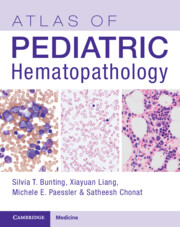96 results
Chapter 18 - Precursor Lymphoid Neoplasms
- from Section IV - Neoplastic Disorders of Bone Marrow
-
-
- Book:
- Pediatric Pathology of Hematopoietic and Histiocytic Disorders
- Published online:
- 25 January 2024
- Print publication:
- 15 February 2024, pp 208-226
-
- Chapter
- Export citation
Implementing a continuous quality-improvement framework for tuberculosis infection prevention and control in healthcare facilities in China, 2017–2019
-
- Journal:
- Infection Control & Hospital Epidemiology / Volume 45 / Issue 5 / May 2024
- Published online by Cambridge University Press:
- 25 January 2024, pp. 651-657
- Print publication:
- May 2024
-
- Article
-
- You have access
- Open access
- HTML
- Export citation
Section V - Histiocytic Neoplasm and Miscellaneous Bone Marrow Diseases
-
- Book:
- Atlas of Pediatric Hematopathology
- Published online:
- 25 November 2023
- Print publication:
- 13 July 2023, pp 257-290
-
- Chapter
- Export citation
Section IV - Precursor Hematopoietic Neoplasms and Related Neoplasms
-
- Book:
- Atlas of Pediatric Hematopathology
- Published online:
- 25 November 2023
- Print publication:
- 13 July 2023, pp 127-256
-
- Chapter
- Export citation
Copyright page
-
- Book:
- Atlas of Pediatric Hematopathology
- Published online:
- 25 November 2023
- Print publication:
- 13 July 2023, pp iv-iv
-
- Chapter
- Export citation

Atlas of Pediatric Hematopathology
-
- Published online:
- 25 November 2023
- Print publication:
- 13 July 2023
Section III - Mature Lymphoid Neoplasm
-
- Book:
- Atlas of Pediatric Hematopathology
- Published online:
- 25 November 2023
- Print publication:
- 13 July 2023, pp 65-126
-
- Chapter
- Export citation
Section I - Peripheral Blood
-
- Book:
- Atlas of Pediatric Hematopathology
- Published online:
- 25 November 2023
- Print publication:
- 13 July 2023, pp 1-30
-
- Chapter
- Export citation
Section II - Normal and Non-neoplastic Hematolymphoid Diseases
-
- Book:
- Atlas of Pediatric Hematopathology
- Published online:
- 25 November 2023
- Print publication:
- 13 July 2023, pp 31-64
-
- Chapter
- Export citation
Contents
-
- Book:
- Atlas of Pediatric Hematopathology
- Published online:
- 25 November 2023
- Print publication:
- 13 July 2023, pp v-vi
-
- Chapter
- Export citation
Index
-
- Book:
- Atlas of Pediatric Hematopathology
- Published online:
- 25 November 2023
- Print publication:
- 13 July 2023, pp 291-296
-
- Chapter
- Export citation
Contributors
-
- Book:
- Atlas of Pediatric Hematopathology
- Published online:
- 25 November 2023
- Print publication:
- 13 July 2023, pp vii-viii
-
- Chapter
- Export citation
Feasibility of low-intensity psychological interventions for emotional and behavioural difficulties in children and young people with genetic conditions: a case series
- Part of
-
- Journal:
- The Cognitive Behaviour Therapist / Volume 15 / 2022
- Published online by Cambridge University Press:
- 12 December 2022, e59
-
- Article
-
- You have access
- Open access
- HTML
- Export citation
STEM Imaging, Monochromated EELS, and Theory of Natural and Artificial Superlattices
-
- Journal:
- Microscopy and Microanalysis / Volume 28 / Issue S1 / August 2022
- Published online by Cambridge University Press:
- 22 July 2022, pp. 1682-1683
- Print publication:
- August 2022
-
- Article
-
- You have access
- Export citation
Cambrian (Stage 4 to Wuliuan) brachiopods from Sonora, Mexico
-
- Journal:
- Journal of Paleontology / Volume 96 / Issue 6 / November 2022
- Published online by Cambridge University Press:
- 01 June 2022, pp. 1264-1284
-
- Article
-
- You have access
- Open access
- HTML
- Export citation
371 Decreased Contraction Rate, Altered Calcium Transients, and Increased Proliferation seen in Patient-specific iPSC-CMs Modeling Ebsteins Anomaly and Left Ventricular Noncompaction
-
- Journal:
- Journal of Clinical and Translational Science / Volume 6 / Issue s1 / April 2022
- Published online by Cambridge University Press:
- 19 April 2022, pp. 69-70
-
- Article
-
- You have access
- Open access
- Export citation
Brachiopods from the Latham Shale Lagerstätte (Cambrian Series 2, Stage 4) and Cadiz Formation (Miaolingian, Wuliuan), California
-
- Journal:
- Journal of Paleontology / Volume 96 / Issue 1 / January 2022
- Published online by Cambridge University Press:
- 06 September 2021, pp. 61-80
-
- Article
-
- You have access
- Open access
- HTML
- Export citation
Early Cambrian (Stage 4) brachiopods from the Shipai Formation in the Three Gorges area of South China
-
- Journal:
- Journal of Paleontology / Volume 95 / Issue 3 / May 2021
- Published online by Cambridge University Press:
- 22 February 2021, pp. 497-526
-
- Article
-
- You have access
- Open access
- HTML
- Export citation
Parity and the risk of incident dementia: a COSMIC study
-
- Journal:
- Epidemiology and Psychiatric Sciences / Volume 29 / 2020
- Published online by Cambridge University Press:
- 20 October 2020, e176
-
- Article
-
- You have access
- Open access
- HTML
- Export citation
First report of acrotretoid brachiopod shell beds in the lower Cambrian (Stage 4) Guanshan Biota of eastern Yunnan, South China
-
- Journal:
- Journal of Paleontology / Volume 95 / Issue 1 / January 2021
- Published online by Cambridge University Press:
- 09 September 2020, pp. 40-55
-
- Article
- Export citation



